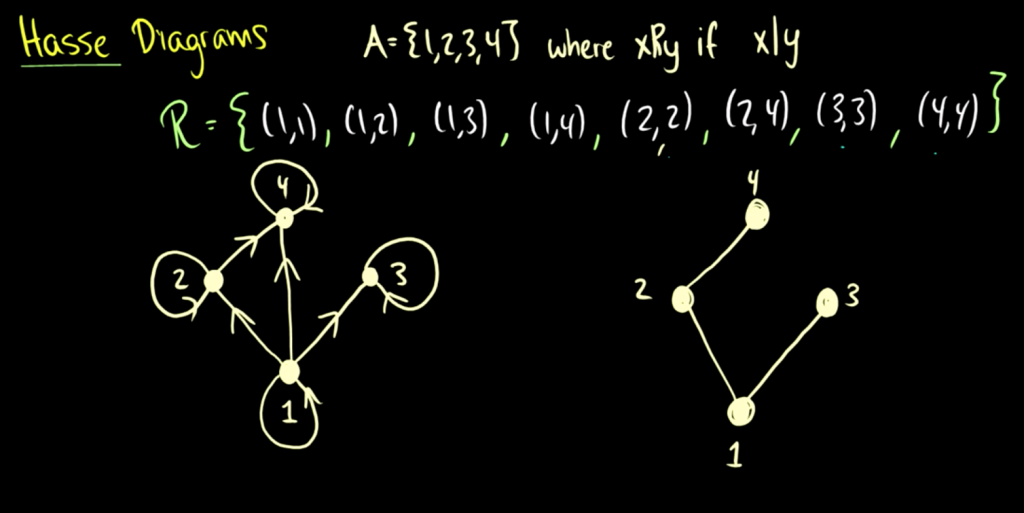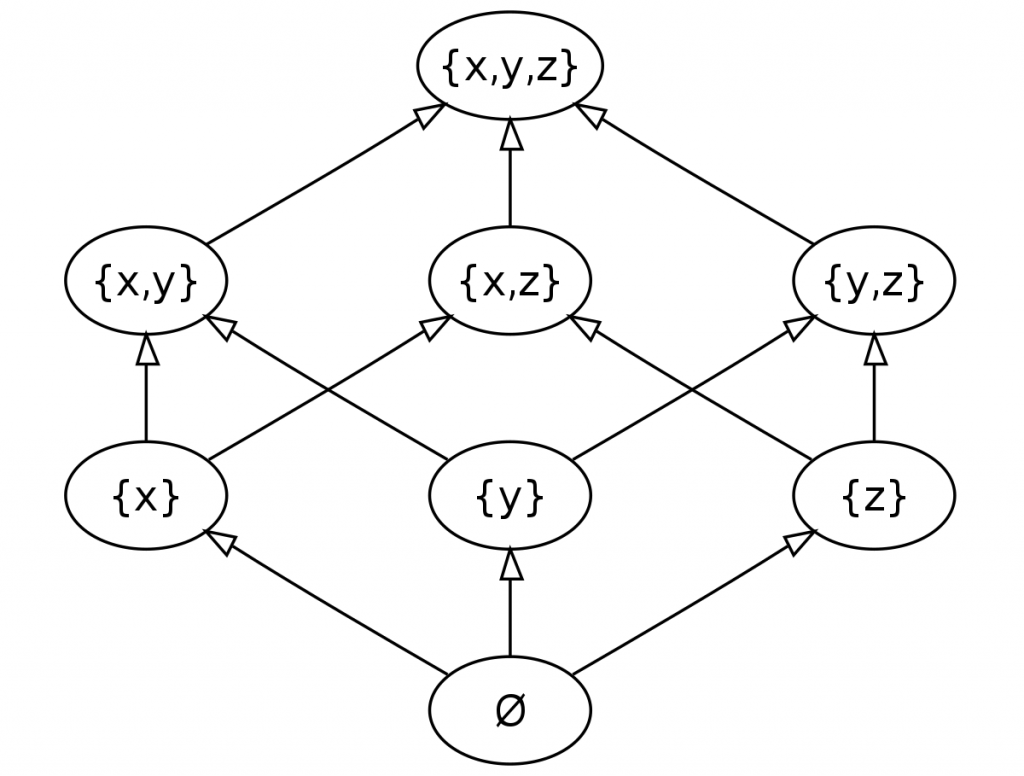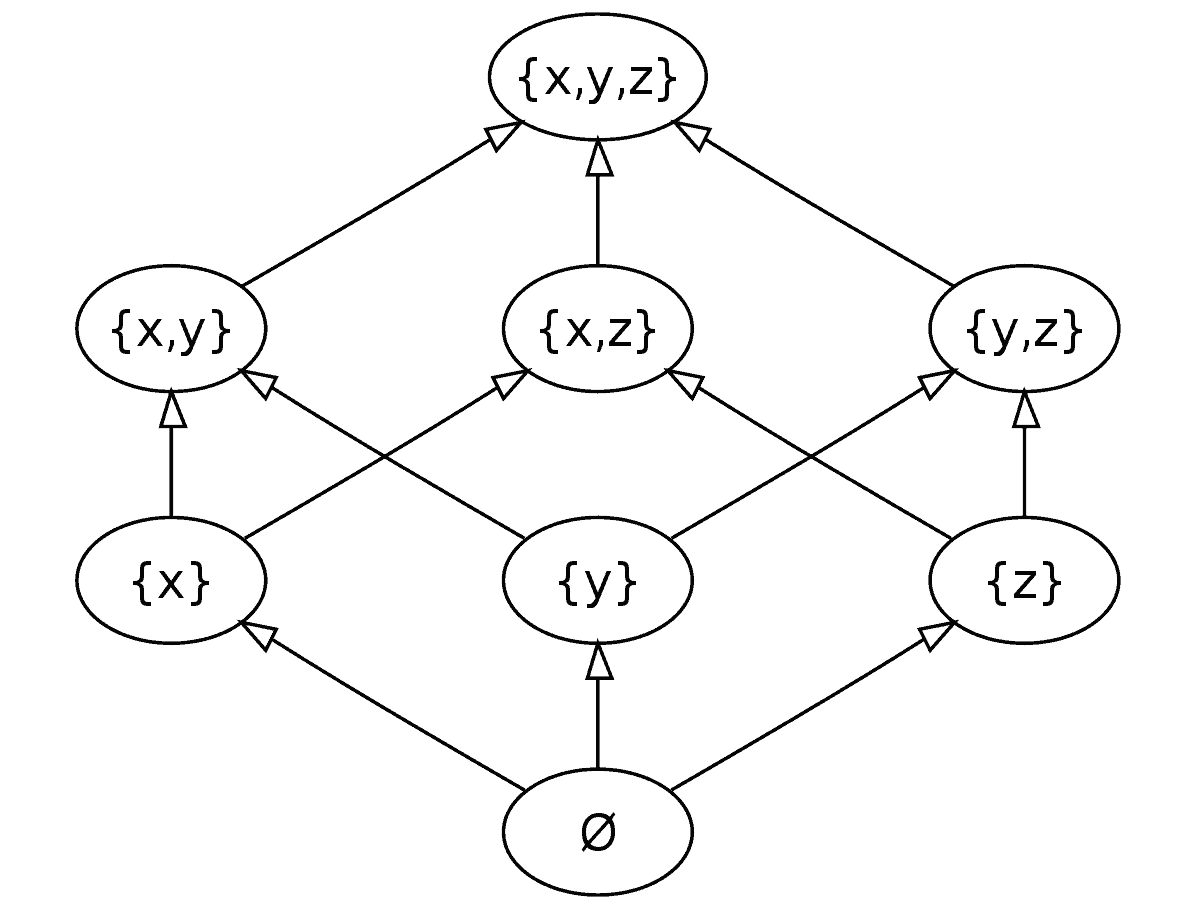如果你也在 怎样代写离散数学Discrete Mathematics 这个学科遇到相关的难题,请随时右上角联系我们的24/7代写客服。离散数学Discrete Mathematics是数学的一个分支,研究一般代数环境中的同源性。它是一门相对年轻的学科,其起源可以追溯到19世纪末的组合拓扑学(代数拓扑学的前身)和抽象代数(模块和共轭理论)的研究,主要是由亨利-庞加莱和大卫-希尔伯特提出。
离散数学Discrete Mathematics是研究同源漏斗和它们所带来的复杂的代数结构;它的发展与范畴理论的出现紧密地联系在一起。一个核心概念是链复合体,可以通过其同调和同调来研究。它在代数拓扑学中发挥了巨大的作用。它的影响逐渐扩大,目前包括换元代数、代数几何、代数理论、表示理论、数学物理学、算子矩阵、复分析和偏微分方程理论。K理论是一门独立的学科,它借鉴了同调代数的方法,正如阿兰-康尼斯的非交换几何一样。
statistics-lab™ 为您的留学生涯保驾护航 在代写离散数学discrete mathematics方面已经树立了自己的口碑, 保证靠谱, 高质且原创的统计Statistics代写服务。我们的专家在代写离散数学discrete mathematics代写方面经验极为丰富,各种代写离散数学discrete mathematics相关的作业也就用不着说。

数学代写|离散数学作业代写discrete mathematics代考|PARTIAL ORDER RELATION
Let $R$ be a relation defined on a set $A$. Then the relation $R$ is said to be a partial order relation in $A$ if $R$ is reflexive, transitive and anti-symmetric.
Consider the relation $\mathrm{R}$ in the real numbers defined by $x \leq y$. i.e. $x \mathrm{R} y: x \leq y$
Reflexive: For all $x \in \mathrm{R}, x \leq x$
i.e.
$x \mathrm{R} x$
i.e. $\mathrm{R}$ is reflexive.
Transitive: Suppose that $x \mathrm{R} y$ and $y \mathrm{R} z$
i.e. $x \leq y$ and $y \leq z$
This implies $\quad x \leq z$
i.e. $\quad x \mathrm{R} z$
i.e. $\mathrm{R}$ is transitive.
Anti-Symmetric: Suppose that $x \mathrm{R} y$ and $y \mathrm{R} x$
i.e. $\quad x \leq \mathrm{y}$ and $y \leq x$
This implies $\quad x=y$
i.e. $\mathrm{R}$ is anti-symmetric.
So, the relation $\mathrm{R}$ in the real numbers defined by $x \leq y$ is a partial order relation.
Theorem
Let $A$ be a set and $R$ be a partial order relation on $A$. Then $\mathrm{R}^{-1}$ is also a partial order relation on $\mathrm{A}$.
Proof : Let $\mathrm{R}$ be a partial order relation defined in a set $\mathrm{A}$. Therefore $\mathrm{R}$ is reflexive, transitive and anti-symmetric.
Our claim: $\mathrm{R}^{-1}$ is a partial order relation.
Reflexive: For all $x \in \mathrm{A}$
This implies $(x, x) \in \mathrm{R}$
$[\because \quad \mathrm{R}$ is reflexive $]$ i.e. $\mathrm{R}^{-1}$ is reflexive.
$(x, x) \in \mathrm{R}^{-1}$
Transitive: Suppose that $(x, y) \in \mathrm{R}^{-1}$ and $(y, z) \in \mathrm{R}^{-1}$
This implies $(y, x) \in \mathrm{R}$ and $(z, y) \in \mathrm{R}$
i.e.
This implies
$(z, y) \in \mathrm{R}$ and $(y, x) \in \mathrm{R}$
i.e.
$(z, x) \in \mathrm{R}$
$[\because \quad \mathrm{R}$ is transitive $]$
i.e. $\mathrm{R}^{-1}$ is transitive.
$(x, z) \in \mathrm{R}^{-1}$
Anti-symmetric: Suppose that $(x, y) \in \mathrm{R}^{-1}$ and $(y, x) \in \mathrm{R}^{-1}$
This implies $(y, x) \in \mathrm{R}$ and $(x, y) \in \mathrm{R}$
This implies
$x=y$
$[\because \quad \mathrm{R}$ is anti-symmetric $]$
i.e. $\mathrm{R}^{-1}$ is anti-symmetric.
Therefore $\mathrm{R}^{-1}$ is a partial order relation in the set $\mathrm{A}$.
数学代写|离散数学作业代写discrete mathematics代考|TOTAL ORDER RELATION
Let $R$ be a relation defined on a set $A$. Then the relation $R$ is said to be a total order relation in A if $\mathrm{R}$ is a partial order relation and for any two elements $x, y$ in A either $xy$ holds.
Consider the relation $\mathrm{R}$ in $\mathrm{D}(6)$ defined by $x \leq y$, where $\mathrm{D}(6)$ is the set of all positive divisors of 6 .
Therefore i.e.
$$
\begin{aligned}
\mathrm{D}(6) & ={1,2,3,6} \text { and } x \text { R } y: x \leq y \
\mathrm{R} & ={(1,1),(1,2),(1,3),(1,6),(2,2),(2,3),(2,6),(3,3),(3,6),(6,6)}
\end{aligned}
$$
So, $\mathrm{R}$ is reflexive, transitive and anti-symmetric. i.e. $\mathrm{R}$ is a partial order relation in $\mathrm{D}(6)$.
Besides this for any two elements $x, y$ belongs $\mathrm{D}(6)$, one of the relations $x \leq y$ or $y \leq x$ holds. Thus the relation $\mathrm{R}$ in $\mathrm{D}(6)$ defined by $x \leq y$ is a total order relation.
Consider another relation $\mathrm{R}$ in $\mathrm{A}={1,2,3, \ldots, 10}$ defined by $x$ is a multiple of $y$.
$$
\begin{array}{cc}
\text { i.e. } & x \mathrm{R} y: x \text { is a multiple of } y \
\text { Reflexive: } & \text { For all } x \in \mathrm{A} \
& x \text { is a multiple of } x \
\text { i.e. } & x \mathrm{R} x
\end{array}
$$
i.e. $\mathrm{R}$ is reflexive.
Transitive:Suppose $x \mathrm{R} y$ and $y \mathrm{R} z$
i.e. $x$ is a multiple of $y$ and $y$ is a multiple of $z$
$$
\begin{array}{ll}
\Rightarrow & x=\mathrm{K}_1 y \text { and } y=\mathrm{K}_2 \mathrm{z} \text { for } \mathrm{K}_1, \mathrm{~K}_2 \in \mathrm{I} ; \mathrm{K}_1, \mathrm{~K}_2 \neq 0 \
\Rightarrow & x=\mathrm{K}_1 \mathrm{~K}_2 z \mathrm{~K}_1, \mathrm{~K}_2 \in \mathrm{I} ; \mathrm{K}_1 \mathrm{~K}_2 \neq 0
\end{array}
$$
i.e. $x$ is a multiple of $z$
i.e. $x \mathrm{R} z$
i.e. $\mathrm{R}$ is transitive.
Anti-symmetric: Suppose $x \mathrm{R} y$ and $y \mathrm{R} x$
i.e. $x$ is a multiple of $y$ and $y$ is a multiple of $x$
$$
\begin{aligned}
\Rightarrow & x & =\mathrm{K}_1 y \text { and } y=\mathrm{K}_2 x \text { for } \mathrm{K}_1, \mathrm{~K}_2 \in \mathrm{I} ; \mathrm{K}_1, \mathrm{~K}_2 \neq 0 \
\Rightarrow & x & =\mathrm{K}_1 \mathrm{~K}_2 x \
\Rightarrow & \mathrm{K}_1 \mathrm{~K}_2 & =1 \
\Rightarrow & \mathrm{K}_1 & =\mathrm{K}_2=1 \quad\left[\because \mathrm{K}_1, \mathrm{~K}_2 \neq 0 \text { and } \mathrm{K}_1, \mathrm{~K}_2 \in \mathrm{I}\right]
\end{aligned}
$$
So, $x=y$, i.e. $\mathrm{R}$ is anti-symmetric. Therefore the relation in A defined by $x$ is a multiple of $y$ is a partial order relation.
Now $R={(1,1),(1,2),(1,3),(1,4),(1,5),(1,6),(1,7),(1,8),(1,9),(1,10),(2,2),(2,4),(2,6)$, $(2,8),(2,10),(3,3),(3,6),(3,9),(4,8),(5,10)}$
Again for 2 and 5 belongs to A either of the relations $2 \leq 5$ or $2 \geq 5$ do not hold because 2 is not a multiple of 5 . Therefore $\mathrm{R}$ is not a total order relation.

离散数学代写
数学代写|离散数学作业代写discrete mathematics代考|PARTIAL ORDER RELATION
设$R$是在集合$A$上定义的关系。如果$R$是自反的、传递的和反对称的,那么关系$R$在$A$中被称为偏序关系。
考虑$x \leq y$定义的实数中的关系$\mathrm{R}$。即$x \mathrm{R} y: x \leq y$
自反性:所有$x \in \mathrm{R}, x \leq x$
例如:
$x \mathrm{R} x$
例如$\mathrm{R}$是自反性的。
传递的:假设$x \mathrm{R} y$和$y \mathrm{R} z$
即$x \leq y$和$y \leq z$
这意味着$\quad x \leq z$
即$\quad x \mathrm{R} z$
例如,$\mathrm{R}$是可传递的。
反对称:假设$x \mathrm{R} y$和$y \mathrm{R} x$
即$\quad x \leq \mathrm{y}$和$y \leq x$
这意味着$\quad x=y$
即$\mathrm{R}$是反对称的。
因此,$x \leq y$定义的实数中的关系$\mathrm{R}$是偏序关系。
定理
设$A$是一个集合,$R$是$A$上的偏序关系。那么$\mathrm{R}^{-1}$在$\mathrm{A}$上也是偏序关系。
证明:设$\mathrm{R}$是定义在集合$\mathrm{A}$中的偏序关系。因此$\mathrm{R}$是自反的、传递的和反对称的。
我们的声明:$\mathrm{R}^{-1}$是一个偏序关系。
自反性:所有$x \in \mathrm{A}$
这意味着$(x, x) \in \mathrm{R}$
$[\because \quad \mathrm{R}$是自反的$]$即$\mathrm{R}^{-1}$是自反的。
$(x, x) \in \mathrm{R}^{-1}$
传递的:假设$(x, y) \in \mathrm{R}^{-1}$和$(y, z) \in \mathrm{R}^{-1}$
这意味着$(y, x) \in \mathrm{R}$和$(z, y) \in \mathrm{R}$
例如:
这意味着
$(z, y) \in \mathrm{R}$和$(y, x) \in \mathrm{R}$
例如:
$(z, x) \in \mathrm{R}$
$[\because \quad \mathrm{R}$是可传递的$]$
例如,$\mathrm{R}^{-1}$是可传递的。
$(x, z) \in \mathrm{R}^{-1}$
反对称:假设$(x, y) \in \mathrm{R}^{-1}$和$(y, x) \in \mathrm{R}^{-1}$
这意味着$(y, x) \in \mathrm{R}$和$(x, y) \in \mathrm{R}$
这意味着
$x=y$
$[\because \quad \mathrm{R}$为反对称$]$
即$\mathrm{R}^{-1}$是反对称的。
因此$\mathrm{R}^{-1}$是集合$\mathrm{A}$中的偏序关系。
数学代写|离散数学作业代写discrete mathematics代考|TOTAL ORDER RELATION
设$R$是在集合$A$上定义的关系。如果$\mathrm{R}$是偏序关系,那么关系$R$被称为a中的全序关系,并且对于a中的任意两个元素$x, y$, $xy$都成立。
考虑$x \leq y$定义的$\mathrm{D}(6)$中的关系$\mathrm{R}$,其中$\mathrm{D}(6)$是6的所有正因子的集合。
因此,即。
$$
\begin{aligned}
\mathrm{D}(6) & ={1,2,3,6} \text { and } x \text { R } y: x \leq y \
\mathrm{R} & ={(1,1),(1,2),(1,3),(1,6),(2,2),(2,3),(2,6),(3,3),(3,6),(6,6)}
\end{aligned}
$$
所以$\mathrm{R}$是自反的,传递的,反对称的。即$\mathrm{R}$是$\mathrm{D}(6)$中的偏序关系。
除此之外,对于任意两个元素$x, y$属于$\mathrm{D}(6)$,关系$x \leq y$或$y \leq x$中的一个保持不变。因此,$x \leq y$定义的$\mathrm{D}(6)$中的关系$\mathrm{R}$是一个全序关系。
考虑$\mathrm{A}={1,2,3, \ldots, 10}$中的另一个关系$\mathrm{R}$,其中$x$是$y$的倍数。
$$
\begin{array}{cc}
\text { i.e. } & x \mathrm{R} y: x \text { is a multiple of } y \
\text { Reflexive: } & \text { For all } x \in \mathrm{A} \
& x \text { is a multiple of } x \
\text { i.e. } & x \mathrm{R} x
\end{array}
$$
例如$\mathrm{R}$是自反性的。
传递性:假设$x \mathrm{R} y$和$y \mathrm{R} z$
即$x$是$y$的倍数,$y$是$z$的倍数
$$
\begin{array}{ll}
\Rightarrow & x=\mathrm{K}_1 y \text { and } y=\mathrm{K}_2 \mathrm{z} \text { for } \mathrm{K}_1, \mathrm{~K}_2 \in \mathrm{I} ; \mathrm{K}_1, \mathrm{~K}_2 \neq 0 \
\Rightarrow & x=\mathrm{K}_1 \mathrm{~K}_2 z \mathrm{~K}_1, \mathrm{~K}_2 \in \mathrm{I} ; \mathrm{K}_1 \mathrm{~K}_2 \neq 0
\end{array}
$$
即$x$是$z$的倍数
即$x \mathrm{R} z$
例如,$\mathrm{R}$是可传递的。
反对称:假设$x \mathrm{R} y$和$y \mathrm{R} x$
即$x$是$y$的倍数,$y$是$x$的倍数
$$
\begin{aligned}
\Rightarrow & x & =\mathrm{K}_1 y \text { and } y=\mathrm{K}_2 x \text { for } \mathrm{K}_1, \mathrm{~K}_2 \in \mathrm{I} ; \mathrm{K}_1, \mathrm{~K}_2 \neq 0 \
\Rightarrow & x & =\mathrm{K}_1 \mathrm{~K}_2 x \
\Rightarrow & \mathrm{K}_1 \mathrm{~K}_2 & =1 \
\Rightarrow & \mathrm{K}_1 & =\mathrm{K}_2=1 \quad\left[\because \mathrm{K}_1, \mathrm{~K}_2 \neq 0 \text { and } \mathrm{K}_1, \mathrm{~K}_2 \in \mathrm{I}\right]
\end{aligned}
$$
所以$x=y$,也就是$\mathrm{R}$是反对称的。因此,由$x$定义的A中的关系是$y$的倍数,是偏序关系。
现在$R={(1,1),(1,2),(1,3),(1,4),(1,5),(1,6),(1,7),(1,8),(1,9),(1,10),(2,2),(2,4),(2,6)$, $(2,8),(2,10),(3,3),(3,6),(3,9),(4,8),(5,10)}$
同样,对于2和5属于A,关系$2 \leq 5$或$2 \geq 5$都不成立,因为2不是5的倍数。因此$\mathrm{R}$不是一个全序关系。
统计代写请认准statistics-lab™. statistics-lab™为您的留学生涯保驾护航。

